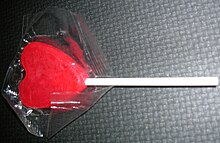| Revision as of 23:33, 11 April 2007 view source75.118.28.40 (talk) ←Replaced page with 'Lollipops are boob bitch suckin assholes who fuck every dick who comes by their vagina. Anal is popular between them. Cum swapping, Masterbbation,And Lesbian sex...'← Previous edit | Revision as of 23:33, 11 April 2007 view source Titoxd (talk | contribs)43,130 editsm Reverted edits by 75.118.28.40 (talk) to last version by Ginkgo100Next edit → | ||
| Line 1: | Line 1: | ||
| For other uses of the term "Lollipop", see ].'' | |||
| Lollipops are boob bitch suckin assholes who fuck every dick who comes by their vagina. Anal is popular between them. Cum swapping, Masterbbation,And Lesbian sex fall into this catagory. | |||
| ] | |||
| A '''lollipop''', '''lolly''', or '''sucker''' is a type of ] consisting mainly of hardened, flavoured ] with ] mounted on a stick and intended for ] or ]. They are available in many flavours and shapes. | |||
| ==Types== | |||
| Lollipops are available in a variety of flavours, particularly fruit flavours. In ], especially the ], ] and ], ]-flavoured lollipops are also available, but these are largely unknown in other parts of the world. With numerous companies producing lollipops, the candy now comes in dozens of flavors and many different shapes. | |||
| Some lollipops contain fillings, such as ] or soft candy. More exotic lollipops may have ]s such as ] ]e embedded.<ref>{{cite web | title = Edible insects | url = http://nationalzoo.si.edu/Publications/ZooGoer/2005/4/edibleinsects.cfm | last = Fromme | first = Alison | date = July/August 2005 | publisher = Smithsonian National Zoological Park | accessdate = 2007-03-24}}</ref><ref>{{cite web | title = ''Tenebrio'' sp., mealworm, in a sticky lollipop | url = http://owen.nhm.ac.uk/piclib/www/image.php?img=58620&frm=ser&search=curiosity | publisher = The National History Museum, London | accessdate = 2007-03-24 }}</ref> | |||
| Some lollipops have been marketed for use as ]s, although their effectiveness is untested, and ] of weight loss may be due to the ].<ref>{{cite web | title = Lollipop Diet helps woman shed pounds |url = http://www.wfaa.com/sharedcontent/dws/wfaa/latestnews/stories/wfaa060208_kd_lollipopdiet.63fd4f8e.html | last = St. James | first = Janet | publisher = WFAA News (Dallas/Fort Worth, Texas) | date = February 8, 2007 | accessdate = 2007-03-24}}</ref> | |||
| ==Terminology== | |||
| The term "lollipop" was first recorded in ] in ], denoting a ] consisting chiefly of sugar or ].<ref>Shorter Oxford English Dictionary, 1973</ref> The first element is perhaps related to "loll", meaning "to dangle" (as in a tongue)—"lolly" was also a northern ] word for the tongue, although this may in fact be derived ] from the mouth sounds associated with sucking and licking. According to another explanation, the term may have originated as a ] from the ]. This theory cites the Romani ''loli phabai'', or "red apple", and notes the term may derive from apples eaten from sticks.<ref>{{cite web | url = http://everything2.com/index.pl?node=Romani | title = Romani words borrowed into English of various dialects | publisher = Everything2 | date = August 1, 2003 | accessdate = 2007-03-24 }}</ref> | |||
| ==References== | |||
| <references/> | |||
| ] | |||
| ] | |||
| ] | |||
| ] | |||
| ] | |||
| ] | |||
| ] | |||
| ] | |||
| ] | |||
| ] | |||
| ] | |||
| ] | |||
Revision as of 23:33, 11 April 2007
For other uses of the term "Lollipop", see Lollipop (disambiguation).

A lollipop, lolly, or sucker is a type of confectionery consisting mainly of hardened, flavoured sucrose with corn syrup mounted on a stick and intended for sucking or licking. They are available in many flavours and shapes.
Types
Lollipops are available in a variety of flavours, particularly fruit flavours. In Europe, especially the Nordic countries, Germany and the Netherlands, salmiakki-flavoured lollipops are also available, but these are largely unknown in other parts of the world. With numerous companies producing lollipops, the candy now comes in dozens of flavors and many different shapes.
Some lollipops contain fillings, such as bubble gum or soft candy. More exotic lollipops may have insects such as mealworm larvae embedded.
Some lollipops have been marketed for use as diet aids, although their effectiveness is untested, and anecdotal cases of weight loss may be due to the power of suggestion.
Terminology
The term "lollipop" was first recorded in England in 1769, denoting a sweetmeat consisting chiefly of sugar or treacle. The first element is perhaps related to "loll", meaning "to dangle" (as in a tongue)—"lolly" was also a northern dialect word for the tongue, although this may in fact be derived onomatopoeically from the mouth sounds associated with sucking and licking. According to another explanation, the term may have originated as a loanword from the Romani language. This theory cites the Romani loli phabai, or "red apple", and notes the term may derive from apples eaten from sticks.
References
- Fromme, Alison (July/August 2005). "Edible insects". Smithsonian National Zoological Park. Retrieved 2007-03-24.
{{cite web}}: Check date values in:|date=(help) - "Tenebrio sp., mealworm, in a sticky lollipop". The National History Museum, London. Retrieved 2007-03-24.
- St. James, Janet (February 8, 2007). "Lollipop Diet helps woman shed pounds". WFAA News (Dallas/Fort Worth, Texas). Retrieved 2007-03-24.
- Shorter Oxford English Dictionary, 1973
- "Romani words borrowed into English of various dialects". Everything2. August 1, 2003. Retrieved 2007-03-24.